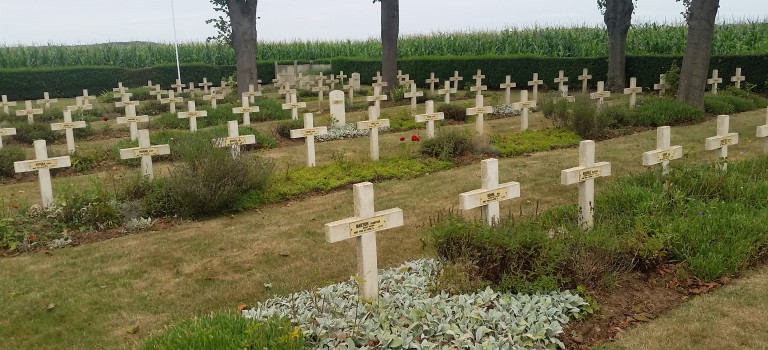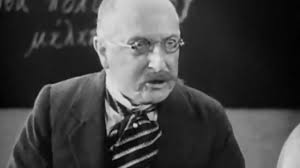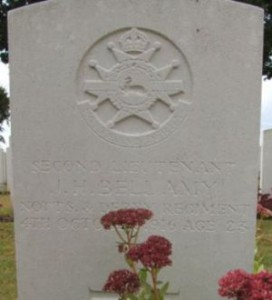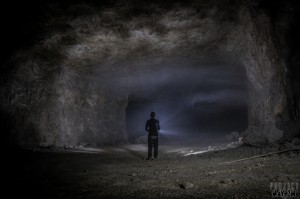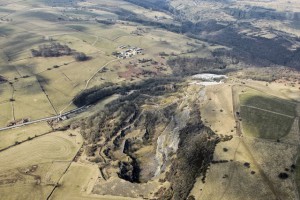Dr Nigel Hunt explores a cemetery dedicated to the often-forgotten Czechs on the Western Front
Between Arras and Bethune, near the village of La Targette there are two monuments, one on either side of the r oad. On the left is a Czech cemetery, containing the remains of the Czech people who fought for France. The cemetery was constructed where the 2nd Battle of Artois took place, where the French and allied forces were trying to retake Vimy Ridge, which had been captured by the Germans in 1914 and provided clear views of the French positions. The area had been heavily fortified with a complex of tunnels, dugouts and machine gun posts – and was known as the Labyrinth.
oad. On the left is a Czech cemetery, containing the remains of the Czech people who fought for France. The cemetery was constructed where the 2nd Battle of Artois took place, where the French and allied forces were trying to retake Vimy Ridge, which had been captured by the Germans in 1914 and provided clear views of the French positions. The area had been heavily fortified with a complex of tunnels, dugouts and machine gun posts – and was known as the Labyrinth.
The battle started on 9 May 1915, with British troops attacking in the north and the 10th French army attacking in the south. While the allies successfully recaptured a number of villages, they failed to retake Vimy Ridge.
The Czech cemetery is at the site of the original hamlet of La Targette (the modern town is to the south). It was originally built to commemorate the contribution of the Czechs to the 2nd battle of Artois, but was later extended to include Czechs who had died elsewhere on the Western Front.
 The Czechs were in an unusual position at the outset of the war. Officially there were to fight for the Austro-Hungarian Empire on the side of the Germans, but many were trying to obtain independence for Czechoslovakia, so would rather fight against the Austro-Hungarians. In the east many were captured by the Russians (sometimes voluntarily) and they formed the Czech Legion to fight against the Austro-Hungarians. In the West, the Czechs who lived in France and elsewhere joined the Czech section of the French Foreign Legion in order to fight for independence. The first unit to fight for the French was the Nazdar Company, made up of 250 men. The name Nazdar comes from the unit’s battle cry, and means ‘Hi’. Eventually the number of Czech and Slovak soldiers came to 150,000 men who had volunteered from around the world. The initial men of the Nazdar company were the ones who fought on 9th May, assaulting and capturing a hill. Around 50 were killed, with another 20 dying of wounds.
The Czechs were in an unusual position at the outset of the war. Officially there were to fight for the Austro-Hungarian Empire on the side of the Germans, but many were trying to obtain independence for Czechoslovakia, so would rather fight against the Austro-Hungarians. In the east many were captured by the Russians (sometimes voluntarily) and they formed the Czech Legion to fight against the Austro-Hungarians. In the West, the Czechs who lived in France and elsewhere joined the Czech section of the French Foreign Legion in order to fight for independence. The first unit to fight for the French was the Nazdar Company, made up of 250 men. The name Nazdar comes from the unit’s battle cry, and means ‘Hi’. Eventually the number of Czech and Slovak soldiers came to 150,000 men who had volunteered from around the world. The initial men of the Nazdar company were the ones who fought on 9th May, assaulting and capturing a hill. Around 50 were killed, with another 20 dying of wounds.
The men stayed in the French Foreign Legion until the end of the war, and then joined their own army of the newly formed Czechoslovakia. In 1925 the Association of the Czechoslovakian Volunteers of France decided to erect a memorial to those who died. [memorial picture here] It was created by the artist Jaroslav Hruska. A commemorative service is still held here each May.
It wasn’t until 1938 that it was proposed to put a cemetery at La Targette. Twenty four lime trees were brought from Czechoslovakia and planted but the Second World War interrupted the development of the site and the cemetery wasn’t built until 1958. In the end 206 graves (including 136 from the Second World War) were brought here from cemeteries around France. The cemetery was officially open in 1963 and the last burials took place in 1970.
 There is a Bohemian cross in the centre of the cemetery [cross image here] reminding the visitor of John of Luxembourg, the king of Bohemia, who died at the Battle of Crecy in 1346. He was blind at the time of the battle, and when he realised the battle was lost, he order two of his soldiers to lead him at the English, who killed him. There is also a monument at Crecy commemorating this suicidal act.
There is a Bohemian cross in the centre of the cemetery [cross image here] reminding the visitor of John of Luxembourg, the king of Bohemia, who died at the Battle of Crecy in 1346. He was blind at the time of the battle, and when he realised the battle was lost, he order two of his soldiers to lead him at the English, who killed him. There is also a monument at Crecy commemorating this suicidal act.
Opposite the Czech cemetery is a memorial to the Polish troops who fought in the French Foreign Legion at the same time as the Czechs. They too were fighting to obtain independence for their homeland.
